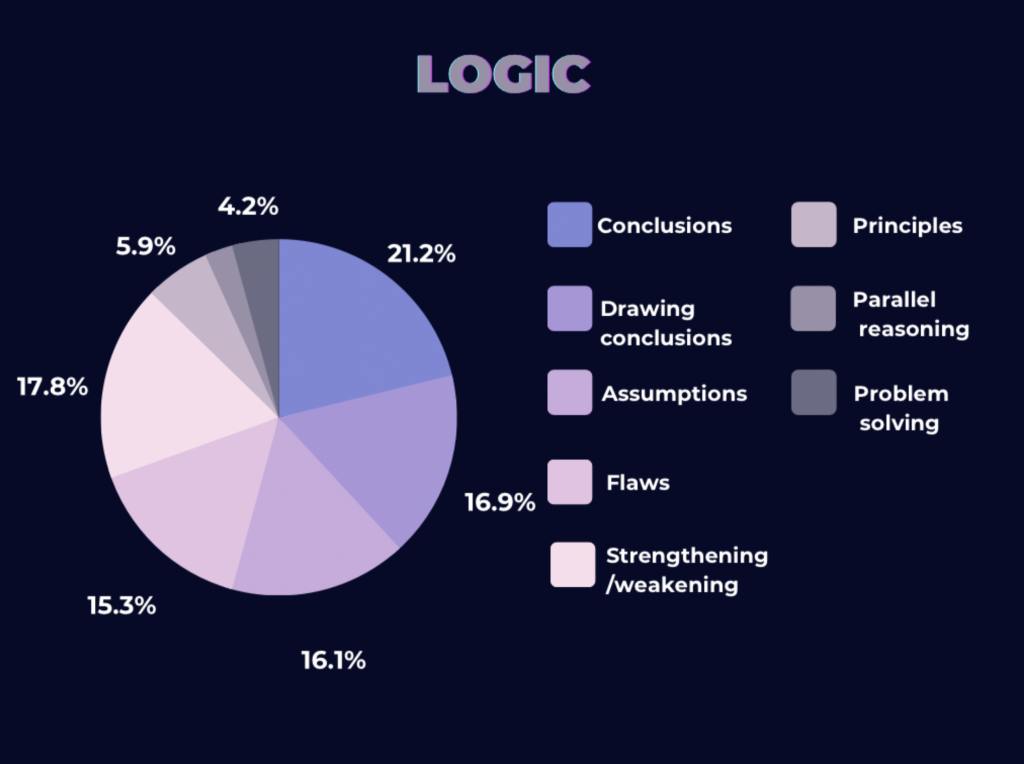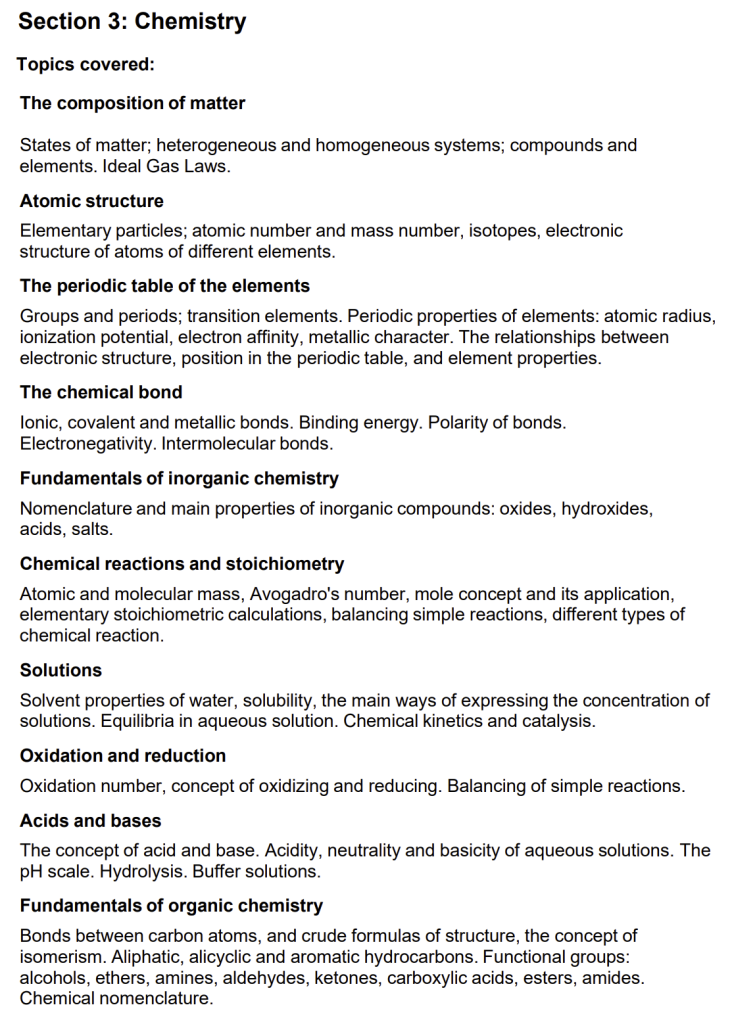

Paris University of Pavia | Ari's Past Student (2020)
10th of April, 2023The International Medical Admission Test (IMAT) is a crucial examination for candidates aspiring to study medicine in English at leading Italian medical schools. In this analysis, we will explore the IMAT 2020 paper, providing an in-depth look into the various sections: Critical Thinking, Problem-Solving, General Knowledge, Biology, Chemistry, Math, and Physics. With an emphasis on identifying patterns, key question types, and the difficulty level of each section, our goal is to help future candidates better understand the scope of the exam and prepare effectively for their IMAT journey.
Content Quick Navigation
Critical Thinking and Problem-Solving
The International Medical Admission Test (IMAT) is designed to evaluate the aptitude of prospective medical students in various skills, including critical thinking and problem-solving. In this analysis, we will explore the types of questions and concepts featured in the Critical Thinking and Problem-Solving sections of this year’s paper, and discuss strategies to tackle them effectively.
Critical Thinking


The Critical Thinking section of the IMAT tests a candidate’s ability to analyze, evaluate, and construct arguments. This year’s paper featured various question types, including drawing conclusions, strengthening arguments, uncovering assumptions, and applying parallel reasoning.
Question Types
Drawing Conclusions
Two questions in this section required candidates to read a passage and identify the most suitable conclusion based on the information provided. To approach these questions, students should:
- Carefully read the passage and identify the main points.
- Evaluate each answer choice to determine which best summarizes the main points or logically follows from the information given.
Strengthening Arguments:
Some questions asked candidates to choose an answer that strengthens the passage’s argument. In these cases, students should:
- Understand the passage’s central claim and supporting evidence.
- Look for answer choices that provide additional evidence or reasons to support the claim, making it more persuasive.
Uncovering Assumptions:
These questions required candidates to identify the underlying assumptions of an argument. To tackle these questions, students should:
- Determine the unstated premises that make the argument’s conclusion valid or false.
- Choose the answer that most accurately reflects these implicit assumptions.
Parallel Reasoning:
In this question type, candidates needed to find a separate argument that followed the same logical structure as the given passage. To approach these questions, students should:
- Analyze the original passage to determine its logical structure and reasoning.
- Compare each answer choice to the original passage, looking for a similar pattern of reasoning or argument structure.
Problem-Solving
Overview:
The Problem-Solving section of the IMAT assesses a candidate’s ability to tackle numerical and spatial challenges, often presented in the form of puzzles. This year’s paper featured questions that required students to apply their quantitative and spatial reasoning skills.
Strategies for Problem-Solving:
Numerical Puzzles:
To solve numerical puzzles, students should:
- Break down the problem into smaller, manageable steps.
- Apply relevant mathematical concepts and techniques.
- Keep track of units, conversions, and calculations to avoid errors.
Spatial Puzzles:
To approach spatial puzzles, candidates should:
- Visualize the problem in 2D or 3D, as appropriate.
- Identify patterns, symmetries, and geometrical relationships.
- Use spatial reasoning skills to determine the correct answer.
General Knowledge


The General Knowledge section of the IMAT evaluates candidates’ understanding of a wide range of topics from various fields, including science, economics, arts, language, and more. While it is difficult to predict the exact questions that may appear in future exams, analyzing the themes and question types from this year’s paper can provide valuable insights and help candidates prepare more effectively.
General Knowledge Themes and Question Types
In this year’s General Knowledge section, questions covered an array of topics, reflecting the diverse areas of knowledge that candidates are expected to be familiar with. For instance, some questions focused on space exploration, asking candidates to identify the achievements of specific astronauts. Others delved into the world of science, requiring test-takers to pair well-known scientists with their groundbreaking discoveries.
Economic principles were also featured in the exam, demonstrating the importance of understanding fundamental economic concepts. Questions related to the arts were present as well, such as those that asked candidates to match films with their respective directors.


This highlights the need for a well-rounded education that encompasses not only science but also the arts and humanities.
Language and culture played a role in this year’s General Knowledge section as well. Candidates were tested on their linguistic knowledge and their ability to pair countries with their official currencies. Additionally, questions about individuals and their prestigious awards or Nobel Prizes showcased the significance of being aware of notable achievements in various fields.
Finally, international organizations emerged as another theme in this year’s exam, emphasizing the value of understanding global institutions and their roles in shaping the world.
Given the unpredictable nature of the General Knowledge section, it’s crucial for candidates to develop a comprehensive understanding of various subjects. While it’s impossible to anticipate every possible question, focusing on the following strategies can help candidates improve their general knowledge:
- Stay updated on current affairs: Regularly read newspapers, watch news programs, and follow reliable news sources online to keep up with global events and developments.
- Read widely: Explore books, articles, and other resources that cover a broad range of topics, such as history, science, literature, and more. This can help build a solid foundation of knowledge in diverse areas.
- Use flashcards and quizzes: Create flashcards or take online quizzes to test your knowledge on various subjects. This can be a fun and effective way to reinforce learning and identify areas that need improvement.
- Engage in discussions: Participate in conversations, debates, or discussion groups related to different topics. This can help deepen your understanding and expose you to new perspectives.
Section 2: Biology




The Biology section of the IMAT assesses candidates’ understanding of fundamental biological concepts and processes. To prepare effectively for this section, it’s essential to review the main topics covered in past exams. In this analysis, we will discuss the key concepts featured in the IMAT 2020 Biology section:
Molecular Biology and Genetics: This category encompasses questions related to DNA, RNA, and genetic processes. Topics from this year’s exam included:
- DNA structure and processes (e.g., replication, transcription, translation)
- Amino acid structure
- Mitosis and meiosis
- Mendel’s laws of inheritance
- Mutations
- Recombinant DNA technology
Cell Biology: This category focuses on the structure and function of cells and their components. Key topics from this year’s paper included:
- Cell membrane structure (fluid mosaic model)
- Cellular structures (organelles)
- Cell sizes
- Cells containing circular DNA
Physiology and Anatomy: This category covers the structure and function of various organs and systems within the human body. This year’s exam featured questions on:
- Eye physiology
- Cardiac Physiology and Anatomy
- Bile function
- Neuronal synapses
- Kidney physiology
Microbiology: This category deals with the study of microorganisms, such as viruses and bacteria
Biochemistry and Metabolism Reactions
In conclusion, the Biology section of the IMAT covers a wide range of topics and can present varying levels of difficulty, as evidenced by the challenging Physiology and Anatomy questions in the 2020 exam. However, candidates need not be intimidated by these challenges. Our comprehensive course is designed to thoroughly cover all aspects of the Biology section, including Human Physiology and Anatomy, ensuring that you are well-prepared for any question the IMAT may present.
2020 IMAT Biology Questions
| Category | Number of Questions |
|---|---|
| The chemistry of living things | 3 |
| The cell as a basis of life | 7 |
| Bioenergetics | 1 |
| Reproduction & Inheritance | 1 |
| Inheritance & Environment | 1 |
| Anatomy & Physiology | 5 |
Section 3: Chemistry


The Chemistry section of the IMAT tests candidates’ understanding of core chemical concepts and principles. This year’s exam featured a fair range of questions, focusing on fundamental concepts. In this analysis, we will explore the main topics covered in the Chemistry section and categorize them accordingly, to help candidates prepare effectively for future exams.


Fundamental Concepts and Principles: This category covers basic chemical concepts and principles, including atomic structure and properties. The concepts from this year’s exam included:
- Chemical formula interpretation
- Mass and atomic number
Chemical Reactions and Equilibrium: This category focuses on different types of chemical reactions, as well as the factors that affect reaction rates and equilibrium. Topics from this year’s paper included:
- Fundamental reactions
- Reactions in equilibrium
- Oxidation and reduction reactions
Intermolecular and Intramolecular Forces: This category encompasses the forces that govern interactions between molecules, as well as those within molecules.
Solutions and Acid-Base Chemistry: This category covers the properties and behaviors of solutions, as well as the principles of acid-base chemistry. Questions from this year’s paper focused on:
- Solutions
- Acids and bases, including pH calculations
- Neutralization reactions
Organic Chemistry: This category examines the structure, properties, and reactions of organic compounds. Topics featured in this year’s exam included:
- Organic isomers
- Functional groups
2020 IMAT Chemistry Questions
| Category | Number of Questions |
|---|---|
| The composition of matter: Atomic Structure | 2 |
| The periodic table of the elements | 1 |
| The chemical bond | 2 |
| Fundamentals of inorganic chemistry | 1 |
| Chemical reactions and stoichiometry | 2 |
| Solutions | 1 |
| Oxidation and reduction | 2 |
| Acids and bases | 1 |
| Fundamentals of organic chemistry | 2 |
Section 4: Mathematics & Physics




The Math and Physics section of the 2020 IMAT evaluates candidates’ understanding of fundamental concepts in both mathematics and physics. This year’s exam was of medium difficulty, as it included both problem-solving questions and more complex concepts, while also extensively testing the fundamentals of physics and mathematics. In this analysis, we will explore the main topics covered in this year’s Math and Physics section and categorize them accordingly, to help you prepare effectively for future exams:


Physics:
This category covers a range of topics in classical and modern physics. Key topics from this year’s exam included:
- Kinematics and Dynamics: This area focuses on the motion of objects and the forces that influence their behavior.
- Thermodynamics: This topic deals with the study of heat, temperature, and their relationship to energy and work.
- Electromagnetism and Mirrors: This category includes the study of electric and magnetic fields and their interactions, as well as the behavior of light in relation to mirrors.
| Topic | Number |
|---|---|
| Kinematics | 1 |
| Dynamics | 1 |
| Thermodynamics | 1 |
| Electrostatic and electrodynamics | 1 |
Mathematics:


2020 IMAT Math Questions
| Category | Number of Questions |
|---|---|
| Algebra and numerical sets | 3 |
| Functions | 1 |
| Geometry | |
| Probability and statistics |
This category covers various topics in mathematics, with a focus on algebra and equations. Questions from this year’s exam centered on:
- Quadratic equations: This topic involves solving equations that include a variable raised to the power of two.
- Square root equations: This area focuses on solving equations involving square roots and their properties.

